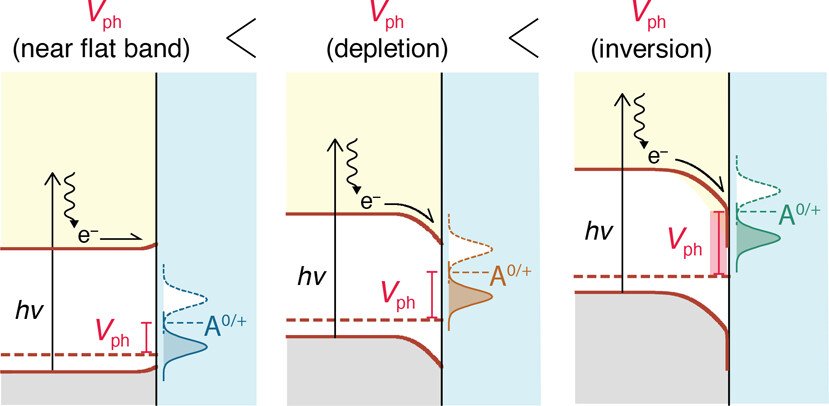Multi-Electron Transfer at H-Terminated p-Si Electrolyte Interfaces: Large Photovoltages under Inversion Conditions
Photovoltages for hydrogen-terminated p-Si(111) in an acetonitrile electrolyte were quantified with methyl viologen [1,1′-(CH₃)₂-4,4′-bipyridinium](PF₆)₂, abbreviated MV²⁺, and [Ru(bpy)₃](PF₆)₂, where bpy is 2,2′-bipyridine, that respectively undergo two and three one-electron transfer reductions. The reduction potentials, E°, of the two MV²⁺ reductions occurred at energies within the forbidden bandgap, while the three [Ru(bpy)₃]2+ reductions occurred within the continuum of conduction band states. Bandgap illumination resulted in reduction that was more positive than that measured with a degenerately doped n⁺-Si demonstrative of a photovoltage, Vₚₕ, that increased in the order MV(2+/+) (260 mV) < MV(+/0) (400 mV) < Ru(2+/+) (530 mV) ∼ Ru(+/0) (540 mV) ∼ Ru(0/–) (550 mV). Pulsed 532 nm excitation generated electron–hole pairs whose dynamics were nearly constant under depletion conditions and increased markedly as the potential was raised or lowered. A long wavelength absorption feature assigned to conduction band electrons provided additional evidence for the presence of an inversion layer. Collectively, the data reveal that the most optimal photovoltage, as well as the longest electron–hole pair lifetime and the highest surface electron concentration, occurs when E° lies energetically within the unfilled conduction band states where an inversion layer is present. The bell-shaped dependence for electron–hole pair recombination with the surface potential was predicted by the time-honored SRH model, providing a clear indication that this interface provides access to all four bias conditions, i.e., accumulation, flat band, depletion, and inversion. The implications of these findings for photocatalysis applications and solar energy conversion are discussed.
Keller, N. D.; Vechi, P.; Grills, D. C.; Polyansky, D. E.; Bein, G. P.; Dempsey, J. L.; Cahoon, J. F.; Parsons, G. N.; Sampaio, R. N.; Meyer, G. J. Multi-Electron Transfer at H-Terminated p-Si Electrolyte Interfaces: Large Photovoltages under Inversion Conditions. J. Am. Chem. Soc. 2023, 145 (20), 11282-11292. https://doi.org/10.1021/jacs.3c01990

